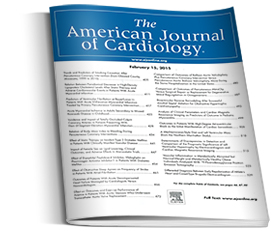 Impact of Baseline Angiographic Complexities Determined by Coronary Artery Bypass Grafting SYNTAX Score on the Prediction of Outcome After Percutaneous Coronary Intervention
Impact of Baseline Angiographic Complexities Determined by Coronary Artery Bypass Grafting SYNTAX Score on the Prediction of Outcome After Percutaneous Coronary Intervention
Nakahashi T, Sakata K, Nomura A, Yakuta Y, Gamou T, Terai H, Horita Y, Ikeda M, Namura M, Takamura M, Kawashiri MA, Yamagishi M, Hayashi K.
Am J Cardiol. 2016 Oct 1;118(7):974-9. ![]()
Impact Factor: 3.154 (2015)
Abstract
Although Synergy Between Percutaneous Coronary Intervention
With Taxus and Cardiac Surgery (SYNTAX) score based on angiographic scoring system was developed in patients with previous coronary artery bypass grafting (CABG), few data exist regarding its prognostic utility in patients undergoing percutaneous coronary intervention (PCI). We examined 272 patients with previous CABG (217 men; mean age, 70.4 ± 9.7 years) undergoing PCI. Severity of the coronary anatomy was evaluated using CABG-SYNTAX score. The primary end point of this study was cardiovascular death. The baseline CABG-SYNTAX score ranged from 2 to 53.5, with an average of 26.0 ± 10.2. In the index procedures, PCI for the native coronary accounted for nearly all patients (88%). During follow-up (median 4.1 years), 40 cardiovascular deaths had occurred. In multivariate analysis, age >75 years (hazard ratio [HR] 2.82, 95% CI 1.45 to 5.52), left ventricular ejection fraction <40% (HR 2.99, 95% CI 1.39 to 6.07), end-stage renal disease (HR 2.90, 95% CI 1.15 to 6.75), peripheral artery disease (HR 2.20, 95% CI 1.10 to 4.64), and CABG-SYNTAX score >25 (HR 2.37, 95% CI 1.19 to 5.05) were independent predictors of cardiovascular death. After creating a composite risk score in consideration of identified predictors, the freedom from cardiovascular death at 5 years was 98%, 86%, and 58% in the low (0 to 1), medium (2), and high (3 to 5) scores, respectively (p <0.001). The area under the receiver-operating characteristic curve for cardiovascular death for the CABG-SYNTAX and composite risk scores were 0.66 and 0.77, respectively (p <0.05). In conclusion, the combination of angiographic and clinical characteristics is useful for risk stratification in patients with previous CABG undergoing PCI.
本論文の背景
冠動脈疾患における冠動脈バイパス手術(CABG:coronary artery bypass grafting)は確立された治療ではありますが、中には手術から数年経過して再び治療が必要となる症例も経験します。バイパス手術の既往を有する症例にカテーテル治療を考慮する際には、もともとの冠動脈の解剖学的複雑性やバイパス血管の開存度、あるいは併存疾患の検索が重要となります。しかし、リスク評価モデルが存在するわけではなく、目の前の患者さんの予後を推測するには十分なデータがないのが現状でした。
独自性・新規性
CABG歴を有する症例へのインターベンションは、変性したグラフト血管や高度石灰化、あるいは慢性完全閉塞など比較的手技難度の高い病変が治療対象となります。本研究では患者の予後に影響を与える要因を探索することに加えて、冠動脈病変の重症度を数値化することを試みています。それでも、臨床データの抽出とアンギオの評価はなかなか骨の折れる作業でした。体力勝負という感じでしたが、地道な作業を通してアンギオの読影力は向上しますし、先輩の先生方の治療方法も学べるので、論文作成を通して副次的に臨床能力もUpすると思っています。
要旨
CABG歴を有するカテーテル治療実施患者272症例を対象としました。後ろ向きの検討ではありますが、治療前のアンギオ所見のみからリスク分類した場合、観察期間5年時における心血管死回避率は低リスク群、中リスク群、高リスク群で94%、92%、75%。一方でアンギオ所見に加えて心血管死の独立予測因子も加味した場合(図B)には、それぞれ98%、86%、58%でした。
本研究の結論を日本語に訳すと、“バイパス手術を既往に有する症例においては冠動脈形態と臨床的特徴を組み合わせることがリスク層別化に重要”ということになるでしょうか。当たり前のことのように思いますが、我々が普段からカンファレンスで意識している冠動脈形態に加え、年齢や腎機能、あるいは心機能やその他の末梢動脈疾患の評価を大切にしていることが実を結んだのだと思います。
今後の展望
今回の研究ではカテーテル治療後のアンギオ所見は考慮されていません。治療が上手くいったかの目安となるので予後に影響する重要な因子と考えられ、今後の検討課題に値すると考えられます。
今回の研究に際してご協力いただいた同僚や先輩の先生方に深く感謝いたします。引き続き御指導の程、よろしくお願い致します。















